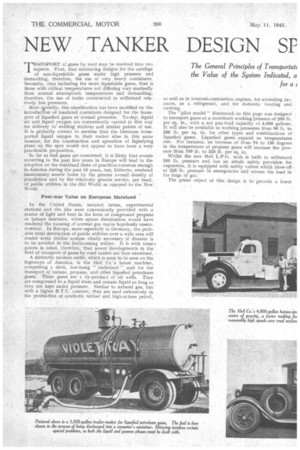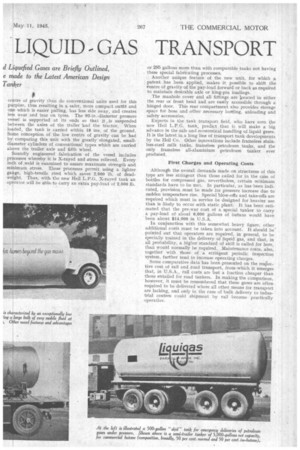NEW TANKER DESIGN SF LIQUID GAS TRANSPORT
Page 30

Page 31

If you've noticed an error in this article please click here to report it so we can fix it.
The General Principles of Transportat: the Value of the System Indicated, a
for a 1
d Liquefied Gases are Briefly Outlined, e made to the Latest American Design Tanker
TRANSPORT of gases by road may be resolved into two aspects. First, that embracing deiigns for the carrikge of non-liquefiable gases under high pressure and demanding, therefore, the use of very heavy containers. Secondly, that including the more liquefiable gases, that is those with critical temperatures not differing very markedly from normal atmospheric temperatures and demanding, therefore, the use of tanks constructed to withstand relatively low pressures.
More ricently, this classification has been modified by the introduction of insulated containers designed for the transport of liquefied gases at normal pressures. To-day, liquid air and liquid oxygen are conveniently carried in this way for delivery to' welding stations and similar points of use. It is probably correct to surmise that the Germans transported liquid oxygen to their rocket sites in. this same manner, for the construction and operation of liquefying plant on the spot would not appear to have been a very practicable proposition.
' So far as fuel gases are concerned, it is likely that events occurring in the past five years in Europe will lead to the adoption on the mainland there of practices common enough inAmerica during the past 10 years, but, hitherto, rendered unnecessary nearer home by the, greater overall density of population and by the relatively greater service, per head, of public utilities in the Old World as opposed to the New World.
Post-war Value on European Mainland
In the United States, ' isolated farms, experimental stations and the like were conveniently provided with a source of light and heat in the form of compressed propane or butane mixtures, where sparse distribution would have rendered the running of normal gas mains hopelessly uneconomical. In Europe, more especially in Germany, the probable total destruction of public utilities over a wide area will render some similar system vitally necessary if disaster is to be avoided in the forthcoming winter. It is with these points in mind, therefore, that newer developments in the field of transport of gases by road tanker are here examined.
A distinctly modern outfit, which is soon to be seen on the highways of America, is the Heil Co.'s latest machine, comprising a sleek, low-hung " trailerized " unit for the transport of butane, propane, and other liquefied petroleum gases. These gases are a by-product of oil wells. They are compressed to a liquid state and remain liquid so long as they are kept under pressure. Similar to natural gas, but with a higher B.T.U, content, they are used extensively in the production of synthetic rubber and high-octane petrol, as well as in internal-combustion engines, for annealing furnaces, as a refrigerant: and for domestic heating and cooking.
The "pilot model" illustrated on this page was designed to transport gases at a maximum working pressure of 250 lb. per sq. in.., with a net pay-load capacity of 4.,000 gallons. It will also be available in working pressures from 80 lb. to 250 lb. per sq. in, for other types and combinations of liquefied gases. Liquefied gases expand as temperatures rise. For instance, an increase of from 70 to 120 degrees in the temperature of propane gases will increase the pressure from 109 lb. to 225 lb. per sq. in.
Whilst the new Heil L.P.G. tank is built to withstand 250 lb. pressure and has an ample safety provision for expansion, it is equipped with safety valves which blow-off at 225 lb. pressure in emergencies and release the load in the fowl of gas.'
The prime object of this design is to provide a lower centre of gravity than do conventional units used for this purpose, thus resulting in a safer, more compact outfit and one winch is easier pulling, has less side sway, and creates less wear and tear on tyres. The 92-in.-diameter pressure vessel is supported at its ends so that it is suspended between the moles of the, trailer 'and the tiactor. When loaded, the tank is carried within 18 ins. of the ground. Some conception. of the low centre of gravity can be had by comparing this unit with the greatly elongated, smalldiameter cylinders of conventional types which are carried above the trailer axle and fifth wheel.
Soundly engineered fabrication of the vessel includes processes whereby it is X-rayed and stress relieved. Every inch of weld is examined to assure maximum strength and minimum stress. These processes permit using a lighter gauge, high-tensile steel which saves 2,000 lb. of deadweight. Thus, with the new Heil L.P.G. X-rayed tank an operator will be able to carry an extra pay-load of 2,000 lb. or 285 gallons more than with comparable tanks not having these special fabricating processes.
Another unique feature of the new unit, for which a patent has been applied, makes it possible to shift the centre of gravity of the pay-load forward or back as required to maintain desirable axle or king-pin loadings.
The manhole cover and all fittings are tocated in either the rear or front head and are easily accessible through a hinged door. This rear compartment also provides storage space for hose and other necessary loading, unloading and safety accessories.
Experts in the tank transport field, who have seen the new Heil L.P.G. tank, predict that it will make a big advance in the safe and economical handling of liquid gases. It is the latest in a long line of transport tank developments by the Heil Co. Other innovations include frameless stainless-steel milk tanks, frameless petroleum tanks, and the only frameless all-aluminium petroleum tanker ever produced.
First Charges and Operating Costs
Although the overall demands made on structures of this type are less stringent than those called for in the case of bottles for compressed gas, nevertheless, certain minimum standards have to be met. In particular, as has been indicated, provision must be made for pressure increase due to sudden temperature rise. Special blow-oils and take-offs are required which must in service be designed for heavier use than is likely to occur with static plant. It has been estimated that the pre-war cost of a special tanker to carry a pay-load of about 6,009 gallons of butane would have been about $14,000 in U.S.A.
In conjunction with this somewhat heavy figure, other additional costs must be taken into account. It should bepointed out that operators are required, in general, to be specially trained in the delivery of liquid gas, and that, in all. probability, a higher standard of skill is called for here, than would normally be required. Maintenance costs, also, together with those of a stringent periodic inspection system, further tend to increase operating charges.
Some comparative data has been-presented on the resPective cost of rail and road transport, from which it emergesthat, in 'U.S.A., rail costs are but a fraction cheaper than those entailed for road tankers. In making the comparison, however, it must be remembered that these gases are often required to be delivered where all other means for transport are lacking, and only in the case of bulk delivery to industrial centres could shipment by rail become practically operative.




























































